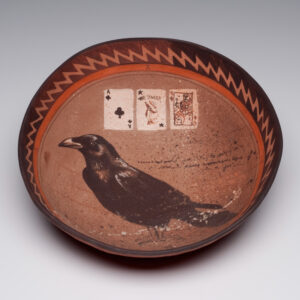Adobe House 1992

Carl Beam, Adobe House, 1992
Handmade sun-dried clay bricks, 3,000 square feet
M’Chigeeng, Manitoulin Island
© Estate of Carl and Ann Beam / CARCC Ottawa 2024
In the summer of 1992, shortly after the completion of The Columbus Project and following its exhibition at The Power Plant Contemporary Art Gallery in Toronto, Carl Beam returned to Manitoulin Island and set about building a home modelled on the adobe brick houses that he had seen in the American Southwest. He and Ann envisioned the house as a way to express a form of Indigenous knowledge from the Southwest. He also felt that it could provide an alternative model for local reserve housing, which was (and remains) plagued by shoddy construction. His uncle had given him five acres of family-owned land adjacent to Beam’s grandfather’s home, where he had been raised. The adobe house was constructed on the site of his grandfather’s potato field. The Adobe House is both a site-specific work of art and a model of affordable housing that is urgently needed in Indigenous communities across Turtle Island.
-
LEFT: Antlers above the side doorway to the Adobe House courtyard in M’Chigeeng, Manitoulin Island, 1994
Photograph by Carl Beam
© Estate of Carl and Ann Beam / CARCC Ottawa 2024
RIGHT: Anong Migwans Beam at the construction site of the Adobe House in M’Chigeeng, Manitoulin Island, n.d.
Photograph by Carl Beam
© Estate of Carl and Ann Beam / CARCC Ottawa 2024
-
Constructing the Adobe House in M’Chigeeng, Manitoulin Island, n.d.
Photograph by Carl Beam
© Estate of Carl and Ann Beam / CARCC Ottawa 2024
-
Constructing the Adobe House in M’Chigeeng, Manitoulin Island, n.d.
Photograph by Carl Beam
© Estate of Carl and Ann Beam / CARCC Ottawa 2024
The Adobe House consists of 3,500 handmade, sun-dried clay bricks. The bricks were laid in ranks and cemented with a mortar of clay, sand, water, and naturally sourced asphalt to make them water-resistant. On the structure’s tan-coloured stucco walls, Beam painted hematite pictographs. The 3,000-square-foot home has been called Beam’s largest ceramic work. The following summer, he built a studio next to the house. It included etched limestone set into the walls.
It was the real, attainable tangibility that Beam celebrated in adobe brick architectural projects. He believed that through directed labour, you could subvert the general life equation in which schooling leads to a job, which leads to a mortgage. In Beam’s vision, building structures from the very earth of Manitoulin Island could result in many jobs. The wood featured prominently in the homes’ decorative and structural elements would advance the fortunes of local sawmills. Moreover, the houses would be of sound construction and would reflect Indigenous values related to being stewards of the land. To promote his vision, Beam invited all the chiefs on Manitoulin Island to visit his work site/studio, where he pitched the idea that adobe brick houses could potentially benefit bands in their search for sustainable housing.

 About the Author
About the Author
 More Online Art Books
More Online Art Books
 Acknowledgements
Acknowledgements